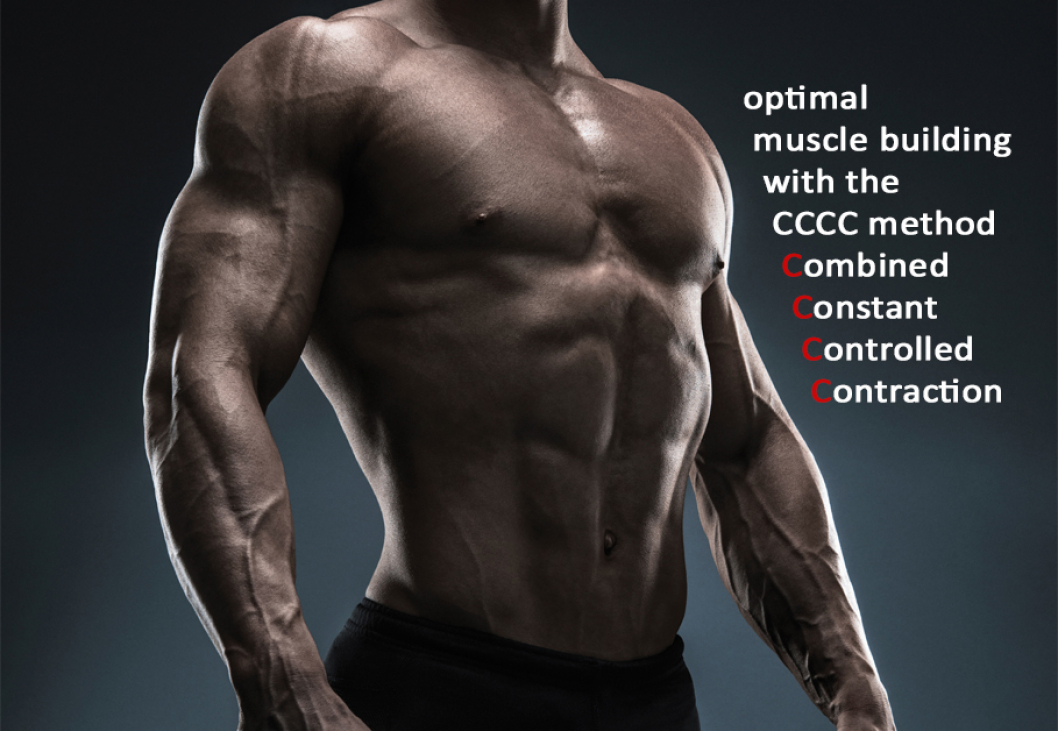Koelbel develops the CCCC method for optimal muscle building

The abbreviation CCCC (pronounced 4C) stands for: Combined Constant and Controlled Contraction.
The aim of the CCCC method is a complete muscle contraction (i.e. muscle tension), which is kept constant and then controlled the muscle evenly loaded in each extent state. The addition "combined" is important here. Only the combination of constant and controlled results in a particularly effective building stimulus for all muscle fibers.
Block 1 - the constant contraction:
Actually, it's quite simple: a muscle develops strength by pulling the muscle fibers together. He can therefore only pull, but never press to make a movement. Only when the muscle gets an exuberant resistance, a growth stimulus arises and the muscles want to grow. If a muscle gets too little resistance, it is just an empty movement without growth stimulus. However, if the resistance is too high, overloads occur and therefore sooner or later injuries and wear. The correct dosage of resistance is crucial.
The right tension in the muscle ensures optimal contraction of muscle fibers
This method is therefore about loading a muscle over the entire phases of movement (concentric, eccentric and desmodromic) with a consistent, uniform and uniform resistance. Leverage and gravity must be excluded. This procedure means that a muscle can never relax, and there is no longer any way that muscle fibers can escape tension. The cheating or falsifying known in other methods is not possible, and even gaining momentum does not bring any relief.
The CCCC method is a combination of 4 different types of sports science training. At the same time, isometric training, isokinetic training and eccentric training as well as desmodromic training are combined in one unit. This combination is comparable to the so-called "isotonic training", which is always referred to in sports science as a theoretical ideal case. Wikipedia writes:
"Isotonic strength training is a form of strength training in which muscle tension remains constant over the entire range of motion, where in which isotonic is a theoretical ideal case. In practice, a completely ideal isotonic movement is not possible. There are devices whose movement resistance is very close to isotonic stress, which enables effective training with a very low risk of injury. This is especially recommended at the beginning of the training or in the area of rehab. Isotonic stress strengthens above all the homogeneity and activation by nerves, and thus the resistance to injury of the muscles."
Block 2 - the controlled contraction:
In the CCCC-method, the resistance is adjusted to a percentage value of the maximum force of the respective muscles. Thus, regardless of performance level, a targeted fatigue of the muscle is always achieved by corresponding progression. This percentage should be about 70% of the maximum force, so that the resistance never overwhelms the muscle but never underwhelms. This method reduces the risk of injury to almost zero when the resistance is additionally applied to tough and elastic, so that small fluctuations are cushioned by the resistance system and no longer by the muscle, tendons or ligaments.
It is therefore crucial that the resistance is not only measurable, but can also be dosed. All blind, uncontrollable methods always fall far short of the possible successes.
Block 3 - the simultaneous combination of constant and controlled
The CCCC method combines the constant tension in the muscle and the controlled contraction in one unit. This requires not only own movement sequences, which are clearly different from conventional methods. A suitable tool is also required that measures, doses and controls the use of force.
It is astonishing that with this method you only need a single exercise for each muscle group in order to set an optimal build-up stimulus in the muscle. Every single muscle fiber is thus reached and controlled, brought to the performance limit. A training session only has to consist of 7 demanding basic exercises, as whole muscle chains are always addressed at the same time. The training is surprisingly short, but still highly intensive.
Block1 + Block 2 + Block 3: The force curve is straightened
By consistently fixing the resistance to the individual value of 70% of the respective maximum force, the recovery phase for complete regeneration is made possible within 48 hours. This allows another full-body workout every 2 days - that is, 7 units in 14 days.
With a unique system, Koelbel training research has succeeded in making the developed CCCC method applicable to everyone and implementing this theoretical ideal case suitable for everyday use and practicality. This system consists of a special training plan with 7 basic exercises and the Isokinator as a tool for measuring, dosing and controlling the force.
More information about the Isokinator of Koelbel can be found here: Isokinator-Training
…
Note: Unfortunately, the term "isotonic training" is often mistakenly associated with dynamic training such as dumbbells. The weight of the dumbbells remains constant, but the resistance in the muscle changes due to the course of movement. An expert quickly recognizes the difference, because the muscle tension decreases. The so-called force curve is not straight. This also applies to the vast majority of other conventional methods, such as training with rubber bands or with fly weights. Even on the large machines in the gym and on train towers, the lever effects can be seen as an alternating resistance, even if the weight seems to remain the same.
Further explanations: Conventional training systems cannot implement the CCCC method. A dumbbell, for example, is also a resistance due to its own weight, but not a particularly suitable one. Due to the different lever effects and the earth-force, constantly changing tension states in the muscle arise. There are always phases in the movement where a resistance that is effective in training no longer arises and can work. In dumbbell training, the training-effective range is usually smaller than half the movement distance. It is therefore necessary to do further exercises for the same muscle, so that all muscle fibers are finally required correctly.
